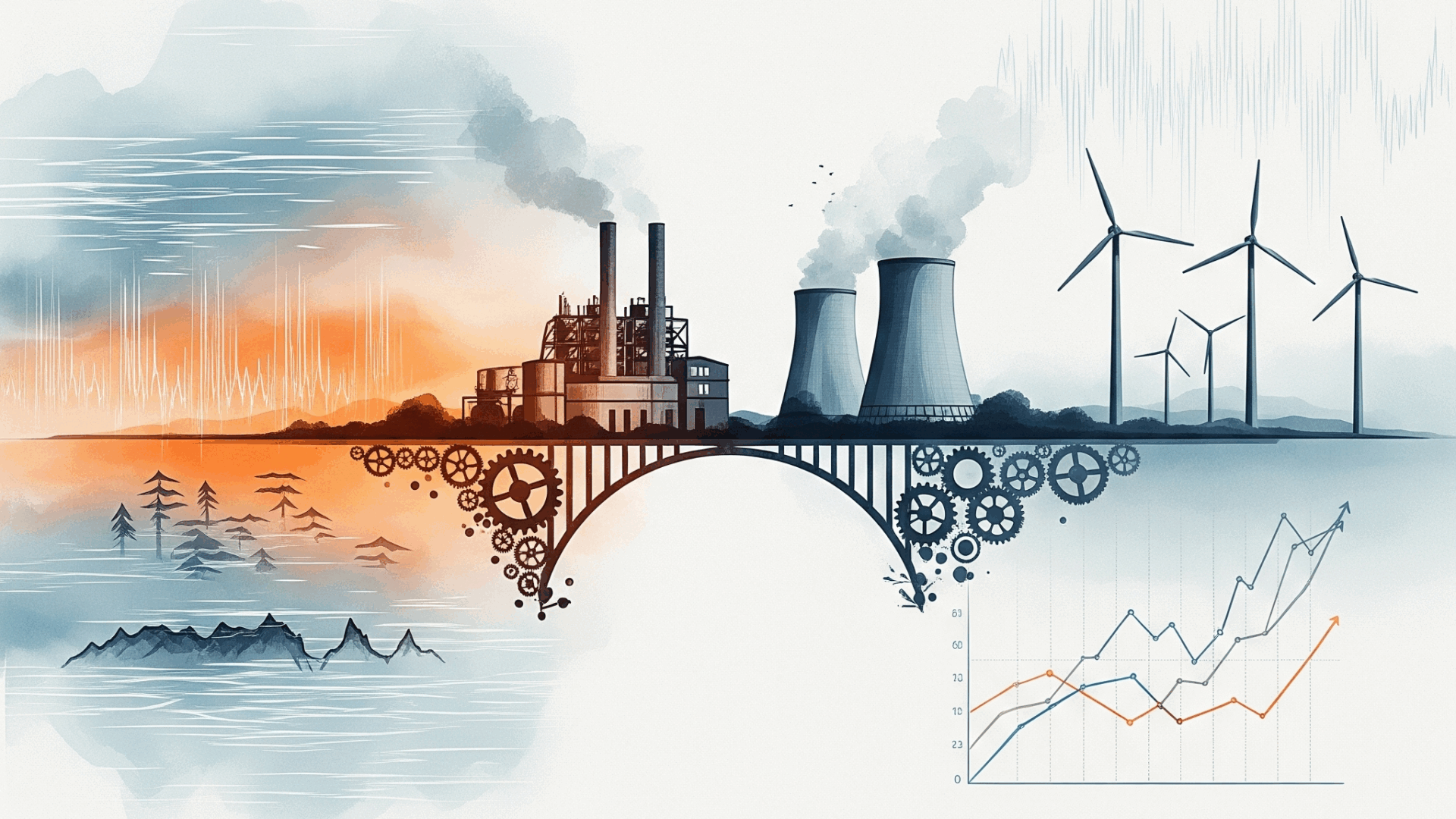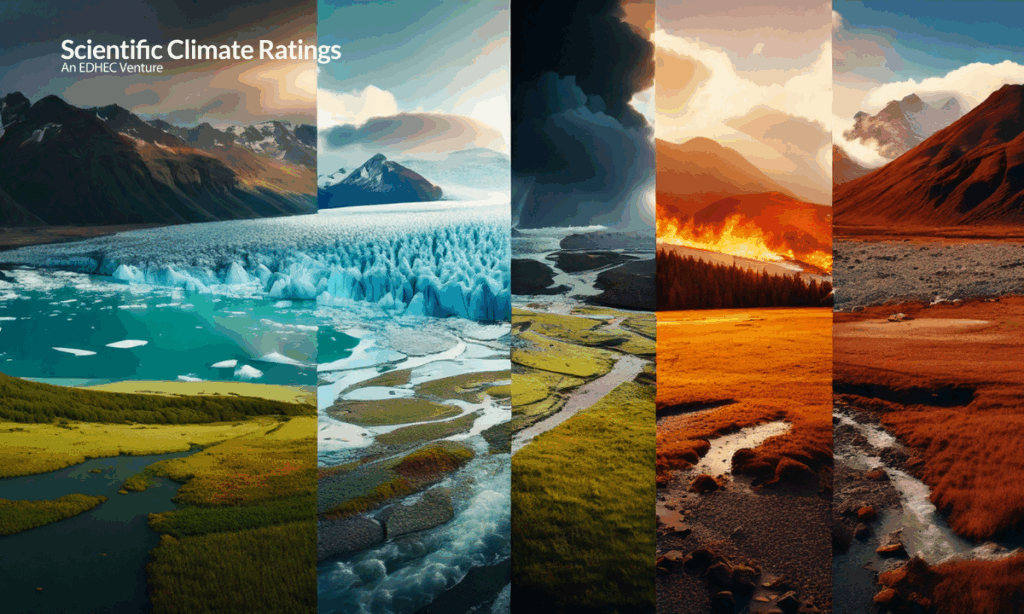
Climate Scenarios and Three Main Categories Investors and Issuers Should Know

Climate scenarios are essential tools for assessing the financial impacts of climate risks and taking resilience measures.
While they are not forecasts that can anticipate the future, these scenarios provide significant frameworks about plausible futures associated with climate change, facilitating risk management for financial decision-makers.
They are widely used by various actors ranging from central banks to financial institutions and policymakers. For long-term investment decisions, they are particularly useful as they support the assessment of climate risks and future planning.
There are several climate scenario models and frameworks developed by recognised organisations such as the Network for Greening the Financial System (NGFS), the Intergovernmental Panel on Climate Change (IPCC) and the Oxford Economics.
Scientific Climate Ratings, an EDHEC venture, assesses physical and transition risks using three main climate scenario categories chosen for their reliable characteristics: Orderly, Disorderly, and No Transition.
In our Effective Climate Risk Ratings (ECRR), we take one step further and weigh these scenarios according to their likelihood, to address a significant gap in climate scenario frameworks. As a result, investors and issuers are provided climate risk ratings that can capture the range of plausible futures and incorporate these insights into risk management, investment planning and mitigation strategies.
In this article, we explain climate scenarios, the three main climate scenario categories, and how we incorporate them into our climate risk ratings to provide actionable financial insights.
What Are Climate Scenarios?
Climate change poses complex and highly unpredictable potential impacts on businesses and financial systems, and due to its unprecedented nature, historical data and analysis about past events provide limited insights into the future. That is why scenario analysis, aiming to explore future climate pathways, is considered an essential tool to navigate the unprecedented nature of climate change.
Climate scenarios are a key component of scenario analysis. These scenarios are described as plausible combinations of variables, consistent with current knowledge about climate change among scientists and researchers. They are projections on how climate change could influence macroeconomic conditions, based on various assumptions about greenhouse gas emissions, socioeconomic developments, and technological advancements.

Climate scenarios serve as projections rather than definitive forecasts, and aim to provide a forward-looking analytical tool for assessing and navigating risks. They are also used to evaluate and identify adaptation strategies.
Initially, these scenarios emerged when a group of scientists outlined a handful of narratives in the 1990s to set the analytical standards for decades to come, so that they could explore how the world would be affected socially and economically by climate change.
However, as the world was evolving, scenario frameworks did too. Currently referred to as shared socioeconomic pathways (SSPs), these narratives were combined with a range of projected carbon emissions, known as Representative Concentration Pathways (RCPs). The Intergovernmental Panel on Climate Change (IPCC) endorsed this approach, known as the SSP-RCP approach, which has become a standard framework.
Climate scenarios are also incorporated in scientific assessments conducted by other international bodies such as the Network for Greening of the Financial Sectors (NGFS), as well as private bodies such as Oxford Economics.
The NGFS adapted climate scenarios in its own framework and made them accessible as a public good, providing a common starting point for analysing the impacts of climate risks on the economy and financial system. These regularly updated scenarios aim to support scenario analysis and financial disclosures, guide strategic decision-making for private and public sectors, and serve as a starting point for further academic research. In addition to long-term scenarios, the NGFS also published the first vintage of short-term scenarios in May 2025, covering a time horizon of three to five years.
Scenarios are characterised by their overall level of physical and transition risk, driven by the level of policy ambition, timing, coordination and technology levers.
Orderly, Disorderly and No Transition
There are three main scenario categories on possible climate futures that are incorporated in scenario frameworks and models, which can be integrated into the investment process: Orderly, Disorderly and No Transition (which is referred to as Hot House World in the NGFS framework).
1- Orderly
This scenario involves the immediate and coordinated application of climate policies.
Physical risks are contained, and transition risks are managed through early, coordinated action, with the aim to reach net-zero emissions by 2050.
2- Disorderly
In this scenario, the net-zero transition is delayed, and carbon taxes are postponed until 2030.
To compensate for the delay, carbon taxes are then introduced sharply as a shock, which entails high transition risks.
3- No Transition
This scenario assumes that climate policies remain unchanged from their current state.
As a result, it leads to low transition risks but high physical risks.
NGFS refers this category as “Hot House World”.
Scenario analysis is increasingly used as part of the climate reporting standards of the International Sustainability Standards Board (ISSB) and is a key recommendation of the Task Force on Climate-related Financial Disclosures (TCFD).
While climate scenarios are widely recognised as a useful analytical tool for policy and academic purposes, they are also crucial for determining the appropriate strategies to enhance portfolio resilience for investors. TCFD suggests that climate scenario analysis can also support capital allocation by examining portfolios of assets and investment opportunities and identifying weaknesses.
Considering their important role for investment strategies, an important question arises. Are current climate scenario approaches offering investors the reliable, comprehensive insights based on a science-based assessment of what ensemble of paths is possible, likely or unlikely? How can climate risk ratings offer decision-useful forward-looking insights using climate scenarios?
Scientific Climate Ratings: Assigning Probabilities to Major Scenarios
Although climate risks are highly uncertain and span a wide range of possible outcomes, most climate scenario models still rely on a single narrative, typically the worst-case scenario, without indicating how likely that outcome is.
At Scientific Climate Ratings, we utilise major climate scenarios that are built on a set of hypotheses and assumptions to assess climate risks. However, we move beyond traditional models in our climate risk ratings when we quantify the financial impact of climate risks. In our ECRR, we integrate climate risk data into financial valuation models across multiple scenarios, each weighted by its probability of occurrence, to estimate the financial impacts of climate-related risks until 2035 and 2050.
Our methodology assigns probabilities to major climate scenarios because they typically lack assigned probabilities and cannot explain how likely the given outcome is. Developed by the EDHEC Climate Institute (Rebonato et al., 2025), SCR’s approach assesses the likelihood of climate scenarios based on the probability distribution of the abatement speed’s aggressiveness. Accordingly, it provides a systematic way to account for uncertainty in the speed and effectiveness of emissions abatement efforts—a major determinant of future climate and economic conditions. Our approach facilitates a more rigorous integration of uncertainty into decision-making, adopting an “expected loss” approach rather than relying solely on worst-case scenarios or isolated “stress tests” for each risk type.
“We go beyond isolated ‘what-if’ scenarios. Instead of focusing only on extremes – like net zero or climate catastrophe – we assess climate risk across a full range of transition and physical scenarios, each with assigned probabilities. This enables us to compute expected changes in asset values, shifting the focus from highly theoretical outcomes to financially likely impacts,” explains Rémy Estran-Fraioli, CEO of Scientific Climate Ratings.
Assigning probability distributions to different projections enables to capture the range of plausible futures and incorporate these insights into risk assessment, allowing for a more balanced evaluation of expected outcomes and tail risks.
Learn more about the science behind our methodology.
Further readings:
“How to Assign Probabilities to Climate Scenarios” by Riccardo Rebonato, Lionel Melin and Fangyuan ZHANG: https://climateinstitute.edhec.edu/publications/how-assign-probabilities-climate-scenarios
